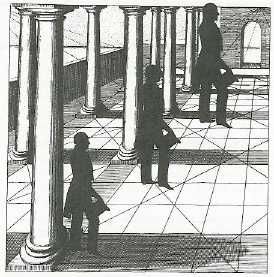Originally Posted by
HaVoC-28 /img/forum/go_quote.gif
Ya their is selector for cheap , and even the DIY is a bit pricey for what it s .
Experimenting is a fun part of this hobby i think , but time to time only
(sorry for the long post, I felt like writing and I'll copy-paste it somewhere else later)
Here is my answer for you why your experiment for slight sonic differences may have failed
in theory.
Whilte it's true that a volume-matched, time-aligned fast switch is necessary for +-0.5dB volume changes, in total volume or at a specificy frequency (frequency response, SPL at xxxxHz etc.), when trying to decipher tone quality or tone colour, humans can automatically be victim to an illusion called
perceptual constancy.
It's an instant process in our subconscious, which can make light and sound look / sound
constant in our mind, when in reality the light on our retina, or signals in our auditory nerve are in
flux.
This is due to that we are more efficient in sorting out constant patterns (like an apple is red) instead of very fine differences all the time (an apple is 50 shades of red) since that takes up unnecessary visual activity.
So when you have the music playing, your subconscious mind is 'locked' into the colour of the apple in the sound, then if the colour of the apple suddenly changes 1% you can't see / hear it! That 1% difference in your auditory nerve was immediately rejected with a subconscious filter, since if we heard +-1% differences in tone all the time, it would become a difficult task to focus.
Visually this happens to you all the time, your mind is deciding on the visual patterns and keeping them static, even if they're in flux.
You see here, check out this lamp, is it brighter than your computer screen?

It looks brighter than your computer screen, except you know that's impossible, so it must be an illusion right? Now
change the brightness on your PC monitor, does it take your mind 0.1 seconds to process the new brightness levels, or is it automatic in the central nervous system, 0.00000000 seconds?
XYZ perception...
XYZ real!
Here is a sound example I found, of pipe organs changing ~10dB in volume at different locations, and the perceived difference is zero -
http://www.ncbi.nlm.nih.gov/pubmed/10923901
So the point is there are two phenonema in audio / visual. One is the "placebo effect" like if you buy fake medicine (sugar pills) and you
think you feel different, or you trick yourself and you
do feel different at a chemical level. The other is the "constance" effect (skip to 7).
If someone buys a $500 HDMI cable, the placebo effect can make them think the picture is improved, since their mind decides so, maybe they even feel happier at a chemical level! =)
Hence...
1. There is no electrical, chemical or physical difference in the new component, so it's an illusion (unless it's spiritual... like it's haunted).
2. There is an electrical / chemical / physical difference in the new component.
2.05. Does the difference have any theory, does the difference appear scientific like a pursuit for higher quality, or does it appear like marketing?
2.1. It measures identical.
2.2. Is the measurement system 100% exact, total, evidenced? Yes/No.
Usually this is "No", the measurement system is typically limited, or the measurements were performed in X specific situation, where they will differ in Y situation, such as in a different electronic circuit or with different acoustics etc.
It seems like people some people prefer "Yes". As an example, see Rightmark Audio Analyzer, you can see it's used all over the internet, with the tone that it measures
everything - while it very much doesn't. They just like this mindset or they like measurements, since they want to
feel secure or
feel above subjectivity, i.e. these are emotional convictions, such as elitism.
3. The component measures different (see 2.2).
3.1. Are the differences in the component within human perception? Yes/No. This is a pretty complicated topic!, you just need to decide for yourself.
Let's use visual processing as an example once more, and reflexes.
-
http://xcorr.net/2011/11/20/whats-the-maximal-frame-rate-humans-can-perceive/
-
http://www.100fps.com/how_many_frames_can_humans_see.htm,
- http://www.youtube.com/watch?v=Qzhs1Z8Rwnk
Is 60Hz refresh rate at the 'limit' of human perception? No it's just 'fine' for consumer-level entertainment. In reality, you can see higher than that. Another example is the Hertz rate of neon lights may not be perceivable at a
conscious level, however your subconscious can actually 'see' the high Hertz rate in neon lights, I'll assume this is unnecessary, confusing information (similar to the shades of red in the apple).
3.1.2. Do you just want entertainment and nice performance, or are the limits of quality and perception important to you? In other words, do you just want to eat apples, or do you want the highest quality apples?
That's up to you. Do you want a basic kitchen knife, or a super sharp kitchen knife for xx price? Do you want basic sneakers, or athletic sprinting shoes for xx price? I'm sure that depends on who you are.
4. Look at statistics and academic papers, well these are usually quite ever-changing and they are very limited in audio compared to other fields IME. See 2.2, people like to use academic papers to feel secure and feel above subjectivity, they are emotional convicts. It's just like using RMAA or more expensive audio equipment with an assertiveness of complete fact.
5. Listen for yourself.
6. Test yourself.
7. Keep in mind you need to practice, and there are illusions within perception, not only illusions of
difference, there are illusions of
sameness.
My hypothesis, if you really want to spend xxx.xx on a kitchen knife, like in high quality audio, you
will hear a difference in DAC's. (I recommend the no-name, non-commmercial ones since they're cheaper so more people can access them and enjoy them).
The available testing is...
1. Limited, since people don't have the time, sophistication, or interest.
2. Flawed, due to the lack of sophistication in the tests, and the perceptual illusions of sameness / constancy in tonal quality / difference / colour.
Now some people will say "He's just desperate to defend his delusions" well no, I don't actually like expensive equipment or marketing in audio, I like cheap DIY level so everyone can hear it, I'm just trying to defend the truth. =)
Some people will defend the null hypothesis, i.e. "until the case is evidenced, it's not valid or true". Yes, that also applies to a murderer in a courtroom though, a lack of evidence
≠ a lack of truth.
See you.























